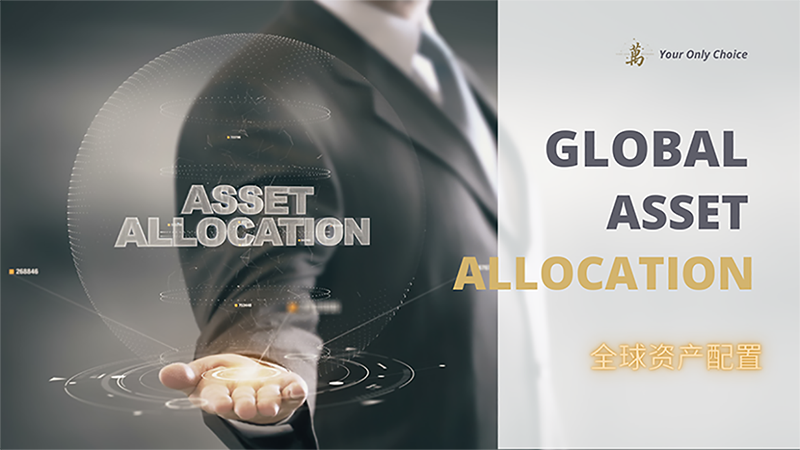
Global Asset Allocation
Gary Brinson, the father of global asset allocation, famously said:
When making investment decisions, it is important to focus on the market and determine the investment category. In the long run, about 90% of investment income comes from successful asset allocation.
What is Asset Allocation?
Asset allocation is the implementation of an investment strategy that attempts to balance risk and return by adjusting the percentage of each asset in a portfolio based on the investor's risk tolerance, goals, and investment time horizon. The focus is on the characteristics of the entire portfolio.
The four basic principles to be followed in asset allocation are:
1. Global Thinking

Layout of overseas assets can hedge against two major risks, exchange rate risk and single market risk.
Investment in a single region creates exchange rate risk. When the national currency depreciates, the accumulated wealth will also directly shrink. If there is an overseas layout, the appreciation of foreign currency can offset the risk of asset depreciation caused by the depreciation of the domestic currency. It is wise for a smart investor to look at the world and use different markets to hedge risks.
2. The selected assets should not fluctuate at the same time

Everyone knows that eggs cannot be put in one basket, but the hard part is finding completely different baskets.
Many people make certain misunderstandings when doing asset allocation, such as buying different types of funds, or thinking that they buy stocks and funds at the same time. I thought that this would successfully diversify the investment risk.
But no matter how many funds you buy, as long as they are stock funds, when the market falls, the funds will fall together. The fundamental reason is that they all belong to the nature of equity, and the essence of stock-type funds is still a package of bones, which is very correlated with stocks. Can not really spread the risk.
The real asset allocation is to find different baskets. This is actually to try to find non-correlated or negatively correlated asset classes.
For example, stocks and bonds are negatively correlated most of the time. When the stock market rises, bond prices fall. The reason is that stocks have higher returns than bonds, so when there is a bull market. Most investors will withdraw money from the bond market and invest in stocks in search of higher returns. So the reaction in the bond market will make the bond price drop. At this time, we say that stocks and bonds show a negative correlation. Then stocks and bonds can be used as two different baskets, but is it enough to have only stocks and bonds? The answer is no. Because in a specific cycle, stocks will also show a certain positive correlation with bonds.
The selection of asset classes in the true sense is far more complicated than this.
3. Take the long view

Jeff Bezos asked Warren Buffett: Since making money is as simple as you said, and long-term value investing is always in the first place, why do so many people fail to make money? Buffett replied: Because people are unwilling to slowly make money.
Allocate time to things that bring value, and compound interest will work.
In fact, the most important thing in investing is not money, but time.
Long-term thinking can help investors avoid timing and the impact of behavioral finance to make wrong decisions that affect returns.
4. Adjust asset allocation in a timely manner to adapt to changes in the investment situation

After implementing the investment strategy, the adjustment of asset allocation includes periodic rebalancing and readjustment of allocation when major changes occur in the form of investment.
To rebalance is to rebalance the portfolio once again. During the investment process, the proportion of the investment portfolio will change with market fluctuations, and this change will cause the original investment setting to deviate from the channel. When the market rises, the proportion of stocks increases, which often increases the risk of the investment portfolio. When the market falls, the proportion of stocks increases, resulting in greater volatility.
Secondly, when there are major changes in the overall investment form, such as the disruption of the global economic cycle after the outbreak of the new crown, then the previously selected allocation needs to be adjusted accordingly according to the new cycle.
To sum it up in one sentence, Nobel laureate Harry Markowitz said: "Diversified asset allocation is the only free lunch in investment."
However, building a mature asset allocation takes a lot of time and effort, and it requires a common working philosophy and a firm determination to win. At the same time, asset allocation has a long-term nature and must withstand the test of herd mentality, but this is not easy to do. WAN Wealth Management helps clients formulate one-to-one overall wealth management plans, and allocate financial assets according to clients' investment cycle, goals and risk tolerance, including fixed income, insurance, equity, real estate, commodities, including alternative investments and other diversified combinations. For the configuration ratio of each type of product, more detailed customization is carried out.